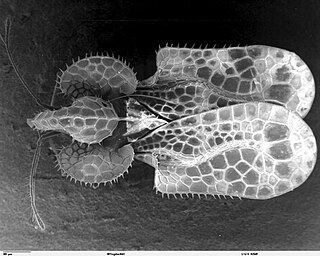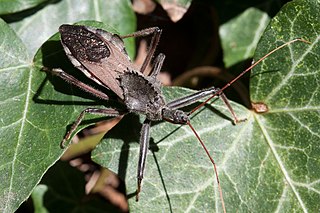Related Research Articles

The Reduviidae is a large cosmopolitan family of the order Hemiptera. Among the Hemiptera and together with the Nabidae almost all species are terrestrial ambush predators; most other predatory Hemiptera are aquatic. The main examples of nonpredatory Reduviidae are some blood-sucking ectoparasites in the subfamily Triatominae. Though spectacular exceptions are known, most members of the family are fairly easily recognizable; they have a relatively narrow neck, sturdy build, and a formidable curved proboscis. Large specimens should be handled with caution, if at all, because they sometimes defend themselves with a very painful stab from the proboscis.

Rhodnius is a genus of assassin bugs in the subfamily Triatominae, and is an important vector in the spread of Chagas disease. The Rhodnius species were important models for Sir Vincent Wigglesworth's studies of insect physiology, specifically growth and development.

The Cimicomorpha are an infraorder of insects in the order Hemiptera, the true bugs. The rostrum and other morphology of all members apparently is adapted to feeding on animals as their prey or hosts. Members include bed bugs, bat bugs, assassin bugs, and pirate bugs.

Arilus, or wheel bugs, is a genus of true bugs in the family Reduviidae, subfamily Harpactorinae and tribe Harpactorini. Most species are found in the Americas.
Ghilianella is a genus of true bug in the subfamily Emesinae. Fifty-eight species have been described, with a distribution from Guatemala to Brazil. The linear form of the species in this genus allow the young larvae to be carried about by the mother or perhaps the father. The larvae of the young can curl around the parent's thorax.

The Harpactorinae are a large subfamily of the Reduviidae. About 300 genera and 2,000 species worldwide have been described. Some of the species of the genera Zelus, Pselliopus, Sinea, and Apiomerus are of interest as biological pest control agents.

Stenolemus is a genus of thread-legged bug (Emesinae). Species of this genus are noted for preying on spiders.

Emesopsis is a genus of tropical bugs (Heteroptera) from the family Reduviidae. There are at least 22 described species, of which one, E. nubila, also occurs in southern Europe.
Bagauda is a genus of thread-legged bug in the Emesinae. 18 species are currently known. Many of the species of this genus are associated with caves, some exclusively so. Bagauda is synonymous with the genus Pleias Kirkaldy, 1901, but Bagauda has become more widely used. The genus is restricted to Old World tropics.

Harpactorini is a tribe of the Harpactorinae. This group is the most diverse of the entire assassin bug family, with 51 genera recognized in the Neotropical Region and 289 genera and 2003 species overall.
Caecina is a genus in the subfamily Ectrichodiinae of Reduviidae ; 16 species have been described, all of them are located in Eastern Asia.

Brontostoma is a neotropical genus of assassin bugs in the family Reduviidae. About 20 species have been described. These species are brightly colored with reds and oranges, and like all members of the Ectrichodiinae, specialize on millipede prey.
Heniartes is a large genus of assassin bugs belonging to the family Reduviidae; 32 species have been described, all from South America.

The Reduviinae are a subfamily of the reduviid assassin bugs. Many members of the subfamily are nocturnal and their lifecycles are generally poorly known. This subfamily is suspected not to be monophyletic.
Pseudometapterus is a little-known genus of thread-legged bug in the subfamily Emesinae. Members of the genus occur in North America and usually have wings that are extremely small or absent entirely, though a winged form of P. umbrosus is known from Southern Illinois.
Liangcoris is a monotypic genus of assassin bugs, in the subfamily Harpactorinae, native to China, containing a single species, Liangcoris yangae.

Sinea is a New World genus of assassin bugs, in the subfamily Harpactorinae. 13 species have been described, mostly from the Southwestern United States and Central America.

LopodytesRondani 1867 is a genus in the family Reduviidae, the assassin bugs. Members of the genus have been unofficially assigned the common name Grass Assassin bugs, but generally this name remains meaningful only to naturalists, because these insects have been too well camouflaged to raise robust public awareness.

Eulyes is a genus of true assassin bugs belonging to the family Reduviidae.
Machadoella is a genus of parasitic alveolates in the phylum Apicomplexa.
References
- ↑ Dmitri Forero (2006). "New records of Reduviidae (Hemiptera: Heteroptera) from Colombia and other Neotropical countries" (PDF). Zootaxa . 1107: 1–47. Archived from the original (PDF) on 2014-03-28. Retrieved 2009-12-06.